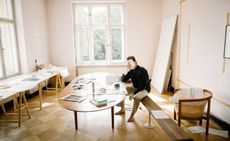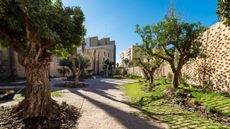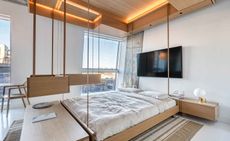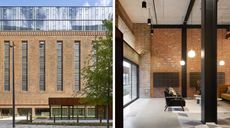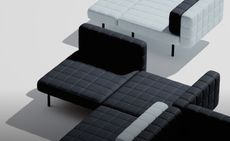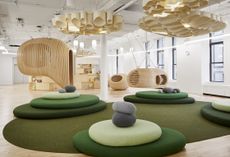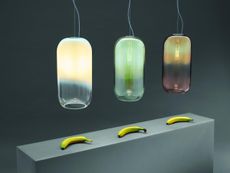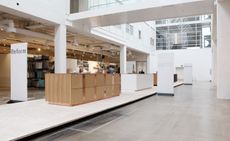BIG and Vestre plan the world’s most sustainable factory
Redefining eco-friendly architecture root and branch, BIG and Vestre aspire to create the world’s most sustainable furniture factory, called The Plus, in the middle of a Norwegian forest
- (opens in new tab)
- (opens in new tab)
- (opens in new tab)
- Sign up to our newsletter Newsletter
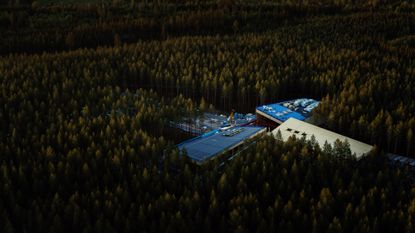
Jan Christian Vestre is on a quest. He wants to create the world’s most sustainable furniture factory – and he is taking his goal suitably seriously. The young CEO of Vestre, a Norwegian outdoor furniture specialist, has been leading this relatively small, family-owned business since 2012, after his father’s passing (Jan Christian is the third generation at the helm), and he has clear plans for it. They include being recognised as the greenest furniture maker on the planet, starting with an exemplary flagship production facility in the middle of a Norwegian forest, designed by Bjarke Ingels Group (BIG).
‘It’s a tool to change the world,’ says Jan Christian. ‘We don’t want to be another company just pushing products to the market.’ The factory is critical in that respect; it’s the first step in promoting a wider shift towards greener practices. ‘People can share life ideas there, have a sense of belonging. It’s about bringing people together. We can create new, enjoyable, profitable jobs and stop climate change; we can do both. We want to prove we can build a factory that can not only meet, but surpass the Paris Agreement measures.’
It’s a tall order, but Jan Christian’s enthusiasm is palpable and his architects share his passion and concerns. ‘Interestingly, the two most sustainable projects we’ve ever done are factories: the CopenHill power plant in Copenhagen, and this,’ says David Zahle, a Copenhagen-based partner and architect at BIG. ‘Coincidence? Not necessarily. Factories are where many environmental problems start and where people can change things directly through their daily job.’

Vestre has form when it comes to architecture: its first factory, designed by David Sandved in 1959, was once described as ‘one of the most beautiful industrial buildings imaginable’; a second factory in Torsby and its Oslo HQ are by none other than Snøhetta. Jan Christian approached BIG directly for this latest commission, having seen its past work and admired its playful approach. He first met Ingels at the opening of another BIG project in Norway, the Kistefos Museum (W*242). ‘We wanted bold ideas and a sense of humour,’ he says. BIG famously does both, from CopenHill’s power-plant-cum-ski-slope, to its Lego House in Billund, which looks like a stack of the beloved bricks, and the Danish National Maritime Museum, whose sunken courtyard resembles the hull of a ship.
Making a building that would be sustainable in every aspect, from its materials to its building methods and future life, is just as hard as it sounds. Many processes are still fairly uncharted territory and the reality of challenging everything in design and construction is certainly not easy – not least because it’s all happening during a pandemic. ‘We had to develop new methods to make things work. There is a lot of glass, for example. We have more than 2,000 sq m of windows [which could have resulted in poorer heat control], but we dealt with thermal bridges, insulation and a façade that has never been done before. We tried to make no compromises,’ explains Vestre. Following the project’s completion, the team intends to share publicly all the technologies they developed and used, for all to see and make use of freely in order to accelerate the transition to green technologies.

The factory, called The Plus, is a low-lying structure that takes its name from its cross-shaped plan. Spanning 130m on each side and with 7,000 sq m of floor space, the building is relatively modest, but uses its space with extreme efficiency, making the most of its outdoor spaces, too. Goods go in at one end, then are split through to the wood factory and the colour factory. Product gets assembled together in the fourth wing and then shipped out on the other side.
‘It’s essentially a big conveyor belt,’ explains Zahle. At the heart of the building, set inside an internal roundabout, is a sunken open courtyard wrapped in glass. The parts of the building that are not glazed will be clad in charred wood. Materials were chosen to be environmentally friendly and hard-wearing, so that the building will need as little maintenance as possible in the future.

The outdoor areas were of critical importance, as the space will be open to all. The public is welcome to visit, walk and rest around the building, or on its planted, accessible roof. There is no fence and it will be available 24/7. ‘It was very important that the people inside could look out into the forest, and people from the outside could look in – so there’s total transparency,’ says Zahle. ‘There are even windows on the roof so visitors can look into the offices.’
The surrounding nature will be part-outdoor showroom and part-playground, filled with playfully stretched, twisted or oversized furniture from Vestre’s catalogue. It will be a bit like an installation within nature, a folly of an urban square inserted into the forest. Meanwhile, the ramp up to the roof and the central staircase inside the courtyard will be painted in various colours representing the 300 colourways in which Vestre produces its furniture, creating a cascading rainbow.
The Plus is due to be completed and operational by the end of 2021; it will then open its doors to visitors in 2022. At the same time, Vestre is improving more parts of its business to reach its sustainability goal. This drive will hopefully be complemented by business growth too. ‘There is a wide range of things that we are doing, and even more that we can do in the future. We are growing fast,’ says Jan Christian. ‘Not that growth in itself is the goal, but this way we can do more.’

INFORMATION
This article appears in the August 2021 issue of Wallpaper* (W*268), on newsstands and available for free download
big.dk (opens in new tab)
vestre.com (opens in new tab)
theplus.no (opens in new tab)
Ellie Stathaki is the Architecture Editor at Wallpaper*. She trained as an architect at the Aristotle University of Thessaloniki in Greece and studied architectural history at the Bartlett in London. Now an established journalist, she has been a member of the Wallpaper* team since 2006, visiting buildings across the globe and interviewing leading architects such as Tadao Ando and Rem Koolhaas. Ellie has also taken part in judging panels, moderated events, curated shows and contributed in books, such as The Contemporary House (Thames & Hudson, 2018) and Glenn Sestig Architecture Diary (2020).
-
 Last chance to see: Cyprien Gaillard on chaos, reorder and excavating a Paris in flux
Last chance to see: Cyprien Gaillard on chaos, reorder and excavating a Paris in fluxWe interviewed French artist Cyprien Gaillard ahead of his major two-part show, ‘Humpty \ Dumpty’ at Palais de Tokyo and Lafayette Anticipations (until 8 January 2023). Through abandoned clocks, love locks and asbestos, he dissects the human obsession with structural restoration
By Harriet Lloyd-Smith • Published
-
 Visit Valencia in 2023: what to see, from ceramics studios to coffee shops
Visit Valencia in 2023: what to see, from ceramics studios to coffee shopsVisit Valencia, as Wallpaper* contributor Blaire Dessent whisks us from an artful hotel to the birthplace of a classic Spanish cocktail in a design-led guided tour
By Blaire Dessent • Published
-
 Men’s Fashion Week A/W 2023: what to expect
Men’s Fashion Week A/W 2023: what to expectWe look forward to Men’s Fashion Week A/W 2023 with must-watch moments from Martine Rose, Gucci, Louis Vuitton and more at Pitti Uomo, Milan and Paris
By Jack Moss • Published
-
 Shape-shifting apartments at Bjarke Ingels’ The Smile
Shape-shifting apartments at Bjarke Ingels’ The SmileA new Bjarke Ingels New York City development plays host to a series of modular, shape-shifting apartment interiors by Bumblebee Spaces
By Rosa Bertoli • Last updated
-
 Inside Battersea Power Station’s first homes
Inside Battersea Power Station’s first homesThe first residents have moved into Switch House West, Battersea Power Station’s first completed section
By Hannah Silver • Last updated
-
 BIG’s first sofa is designed to be moved, flipped and repaired
BIG’s first sofa is designed to be moved, flipped and repairedTake a first look at Bjarke Ingels Group’s modular sofa system for Danish furniture company Common Seating named Voxel
By Sujata Burman • Last updated
-
 WeWork and BIG reimagine education with WeGrow, a new school in New York
WeWork and BIG reimagine education with WeGrow, a new school in New YorkBy Luke Halls • Last updated
-
 House plants steal the spotlight under BIG and Artemide’s new life-enhancing lamp
House plants steal the spotlight under BIG and Artemide’s new life-enhancing lampBy Luke Halls • Last updated
-
 New Danish brand Reform taps big-name architects for affordable kitchen range at Northmodern
New Danish brand Reform taps big-name architects for affordable kitchen range at NorthmodernBy Sujata Burman • Last updated
